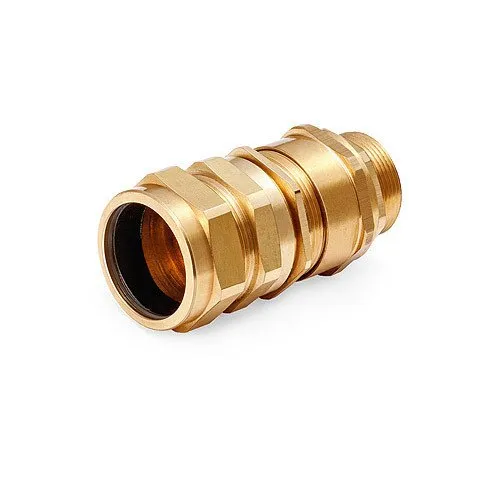Anti-explosion glands are generally produced and designed in two armored and non-armored models. Armored gland and non-armored gland are two different types of glands that differ in terms of outer covering. Armored cable glands are a special type of gland that is generally used for cables with shielded wire mesh. Cables that are going to be installed on equipment and devices in hazardous environments usually use armored cables to increase safety.
What is an armored gland?
Armored cable glands are a special example of types of glands that are usually suitable for cables with shielded wire weave. For cables that are supposed to be placed on explosion-proof equipment and devices in environments with a high risk factor (explosion-prone areas). Armored cables are usually used for installation to increase safety and prevent explosions. Armored cables are larger in size than normal cables. As a result, accurate evaluation of glands in terms of size should be prioritized. These cables are created for ATEX certified braided wire cables in hazardous areas.
Armored cables are usually made of stainless steel material or in some cases of brass material. Naturally, this type of structural material can best resist pressure and environmental forces. The most important feature of glandular metal materials is that they are not easily corroded by chemical processes. Therefore, you can safely use them in humid environments. Due to the high security that armored cable gland has, it is often known as explosion-proof cable.
Armored Gland is able to show its stable properties in the temperature range of minus 40 to 100 degrees Celsius. Also, these glands use the IP68 standard to be waterproof.
Armored cable gland components

sealing nut
This nut is mainly used to protect all kinds of cables and cable clamps. Note that this part is used to connect and protect the end of the power cable to the equipment.
The structural material of the sealing nut is usually made of stainless steel and stainless steel, which is completely resistant to corrosion. It can also be made from metals such as high-density aluminum and nickel- and chrome-plated brass.
seal
The sealing part is a type of lock nut that has an elastic and polymer structure. This part can precisely prevent the possible rotation of the metal nut. The main diameter of this lock nut is smaller than the metal nut, so it fits easily inside and prevents the main nut from twisting by creating structural friction.
Armored cable gland body
The body of the armored cable gland has larger dimensions than other parts of the gland, and other smaller parts such as washers are placed at its end. With the full support of the main body of the power cables, we will not see the accidental disconnection of the cable from the electronic equipment.
- Plastic
- stainless steel
- Steel
- aluminium
lock nut
The locking nut is a small cylinder with relatively small dimensions that is used to engage the cable with the main components of the gland. The lock nut can provide a fully sealed mechanical system to support the power cable. In terms of its structural type, it is very similar to O-rings, and in some ways it can prevent cable stretching.
Armoured Clamping Cone
The conical clamp is another component of the armored gland. This part prevents cables from slipping and pulling out of the gland by putting slight pressure on the cable body. This part has two circular sections with different dimensions. which enters from one side of the cable and exits from the other side. Cones enable round and square tubes to be clamped with simple placement.
Compression Nut
This relatively long cylindrical piece will also have comprehensive support for the cables so that by applying controlled forces on the cable and creating slight friction, it can tighten the cable inside the gland.
Art tags
Armored cable earth tags are made of metal and are used for earthing metal glands. This part also has a hole at the end of the tag to connect the ground conductor and is easy to install. Usually when connecting to armored cable. Several stylish external connecting cables are used directly to ground. The earthing tag serves as a means of connecting or grounding around the cable gland.
Applications of armored cable gland
Gland armored cable has very wide applications in various industries. For this reason, their use cannot be limited in boards and small equipment. For this reason, some of the industries and organizations that use these parts in abundance include the following.
For example, in factories that mostly deal with the processing of gaseous materials or any type of flammable material, the occurrence of any short circuit can cause explosions and fires. The use of anti-explosion glands can prevent these risks.
- Petrochemical and oil refinery industries
- Natural gas processing companies
- Chemical fiber production factories
- Industries that produce all kinds of paints and flammable compounds
- Factories for the production and processing of all kinds of medicines
- Industries that mostly deal with the manufacture and production of explosives
- All electronic workshops
- Workshops for assembly and production of communication devices
Cable pipes are generally designed and manufactured from several different materials. This smart move can lead to budget management as well as product price reduction. In environments where there is no physical stress, there is no need to use high hardness glands. For this reason, you can use examples with a weaker structure. But in general, cable glands are made of materials such as plastic or compressed polymers, brass, galvanized steel and stainless steel. This type of tuber is classified from low to high hardness. Therefore, in work environments where, in addition to high humidity, there are physical stresses such as force and pressure, it is better to use tubes with a stronger structure.

